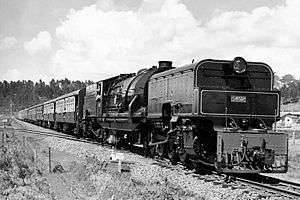KUR EC4 class
|
EAR 5402 with a passenger train at Limuru, Kenya | |||||||||||||||||||||||||||||||||||||||||||||||
| |||||||||||||||||||||||||||||||||||||||||||||||
| |||||||||||||||||||||||||||||||||||||||||||||||
| |||||||||||||||||||||||||||||||||||||||||||||||
| |||||||||||||||||||||||||||||||||||||||||||||||
| [1] | |||||||||||||||||||||||||||||||||||||||||||||||
The KUR EC4 class, later known as the EAR 54 class, was a class of 1,000 mm (3 ft 3 3⁄8 in) gauge 4-8-2+2-8-4 Garratt-type articulated steam locomotives developed under and for use in wartime conditions.
The seven members of the class were built during the latter stages of World War II by Beyer, Peacock & Co. in Manchester, England, for the War Department of the United Kingdom and the Kenya-Uganda Railway (KUR). They entered service on the KUR in 1944, and were later operated by the KUR's successor, the East African Railways (EAR).[2]
Class list
The builder's and fleet numbers of each member of the class were as follows:[3][4]
|
See also
References
Notes
- ↑ Ramaer 1974, pp. 63–64, 70, 86, 88.
- ↑ Ramaer 1974, pp. 63–64.
- ↑ Ramaer 1974, pp. 63–64, 70.
- ↑ Durrant 1981, p. 196.
Bibliography
- Durrant, A E (1981). Garratt Locomotives of the World (rev. and enl. ed.). Newton Abbot, Devon, UK; North Pomfret, Vt, USA: David & Charles. ISBN 0715376411.
- Durrant, A E; Lewis, C P; Jorgensen, A A (1981). Steam in Africa. London: Hamlyn. ISBN 0600349462.
- Patience, Kevin (1976). Steam in East Africa: a pictorial history of the railways in East Africa, 1893-1976. Nairobi: Heinemann Educational Books (E.A.) Ltd. OCLC 3781370.
- Ramaer, Roel (1974). Steam Locomotives of the East African Railways. David & Charles Locomotive Studies. Newton Abbot, Devon, UK; North Pomfret, Vt, USA: David & Charles. ISBN 0715364375.
- Ramaer, Roel (2009). Gari la Moshi: Steam Locomotives of the East African Railways. Malmö, Sweden: Stenvalls. ISBN 9789172661721.
- Staff writer (June 1956). "The "54" Class Locomotives". East African Railways and Harbours Magazine. East African Railways and Harbours. 2 (9): 308. Retrieved 8 December 2014.
External links
![]() Media related to KUR EC4 class at Wikimedia Commons
Media related to KUR EC4 class at Wikimedia Commons
This article is issued from Wikipedia - version of the 7/12/2015. The text is available under the Creative Commons Attribution/Share Alike but additional terms may apply for the media files.
